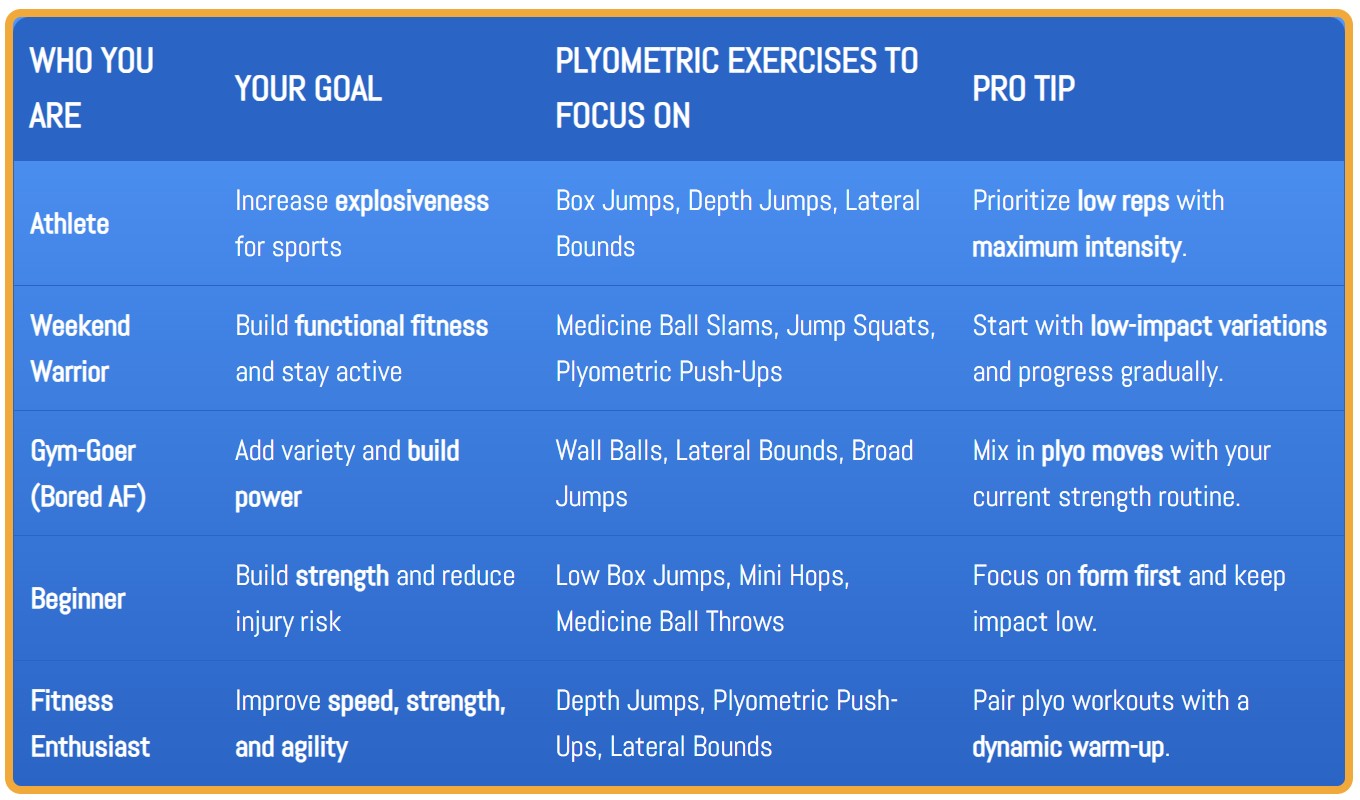Alright, listen up. You want power? Speed? The kind of explosiveness that makes people stop and think, “What the hell are they training for?” That’s where plyometrics come in. This isn’t some fluffy fitness trend—it’s real-deal training designed to help you build explosive strength, improve athletic performance, and dominate in sports, workouts, or just life in general.
Whether you’re an athlete, a weekend warrior, or just someone who’s tired of the same boring gym routine, this guide will show you exactly how to integrate plyometric exercises into your training. Plus, I’ll break down why plyometrics work, how to start, and give you five explosive moves that’ll leave you feeling powerful AF. Let’s get into it.
Plyometrics Explained
Here’s the simple version: Plyometrics (a.k.a. jump training) is a high-impact exercise method that uses rapid, explosive movements to develop your muscles, tendons, and nerves. It’s all about using the stretch-shortening cycle—a fancy term for pre-stretching muscles before they contract. The result? More power in less time.
Think about a rubber band: the further you stretch it, the harder it snaps back. That’s your musculotendon unit (fancy way of saying your muscles and tendons working together). Plyometrics trains that system to produce maximum force in short time frames.
Table: How to Integrate Plyometrics into Your Training

Why Do Plyometrics Work?
Let’s keep it real: Plyometrics isn’t about building large muscles. It’s about harnessing power and increasing speed, agility, and explosiveness. Here’s how it works:
- Stretch Reflex: During a plyometric movement, your muscle stretches rapidly, stores elastic energy, and then contracts forcefully.
- High Forces, Short Time: Plyometrics trains your body to handle large forces quickly—perfect for athletes and anyone looking to improve their physical performance.
- Dynamic Adaptation: This isn’t static training. Plyometrics challenges your muscles, tendons, and nervous system to work together, making your body more functional and adaptable for sports or everyday activities.
Benefits of Plyometric Training
Here’s why you should stop skipping this in your workout program:
| Benefit | Why It Matters |
|---|---|
| Explosive Power | Builds strength and speed together, helping you jump higher and run faster. |
| Improved Agility | Helps you change direction and stop/start quickly—essential for sports. |
| Better Muscle Coordination | Forces nerves, tendons, and muscles to work together in perfect harmony. |
| Injury Prevention | When done right, it strengthens your tendons and joints, reducing injury risk. |
| Sports Performance | Ideal for athletes in basketball, tennis, soccer, and any high-speed sport. |
Safety First: Before You Start
Let’s get something straight: Plyometrics is high impact. If you’re new to training or have injuries, this isn’t where you start. Build a base level of strength and flexibility first. Do some low-intensity movements before jumping straight into the hard stuff.
Also: connect with a health professional if you’re unsure or recovering from an injury. Bad form or overtraining can lead to problems—you’ve been warned.
5 Explosive Plyometric Moves to Try Today
Now, the good part. These five plyometric exercises will torch your muscles, improve speed, and make you feel like an athlete. Perform these 1-2 times a week, and keep reps short and intense (think 3-6 sets of 6-10 reps).
1. Box Jumps
- Why It Works: Builds explosive lower-body power.
- How to Do It:
- Start with a box or platform (18-30 inches).
- Squat slightly, swing your arms, and jump up.
- Land softly with knees slightly bent.
- Pro Tip: Focus on height and soft landings to minimize impact.
2. Depth Jumps
- Why It Works: Trains the stretch-shortening cycle, making your jumps more explosive.
- How to Do It:
- Stand on a box (12-24 inches).
- Step off, land briefly, then explode into a vertical jump.
- Pro Tip: Keep ground contact as short as possible.
3. Medicine Ball Slams
- Why It Works: Builds upper-body explosiveness.
- How to Do It:
- Grab a medicine ball (8-12 lbs).
- Raise it overhead and slam it down as hard as possible.
- Pick it up and repeat.
- Pro Tip: Keep your core tight and engage your entire body.
4. Lateral Bounds
- Why It Works: Improves agility and side-to-side power.
- How to Do It:
- Stand on one leg, then jump laterally to the opposite leg.
- Land softly and stabilize before repeating.
- Pro Tip: Focus on distance and control.
5. Plyometric Push-Ups
- Why It Works: Builds upper-body explosiveness for sports or general strength.
- How to Do It:
- Start in a push-up position.
- Lower down, then explode up, lifting your hands off the ground.
- Land softly and reset.
- Pro Tip: Keep reps controlled—this isn’t about endurance.
Plyometric Guidelines for Maximum Gains
Here’s how to make plyos work for you:
- Warm Up First: Always do a proper warm-up. Think dynamic stretches, light jumps, or low-impact movements.
- Start Low and Progress: If you’re new, focus on low-intensity exercises like jump squats or wall balls. Build up to the high-impact stuff.
- Short and Intense: Plyometrics isn’t about long workouts. Keep sessions 30 minutes max and prioritize quality over quantity.
- Rest Between Sets: Take brief rests (30-90 seconds) between sets to let your muscles recover and produce maximum force.
Who Should Try Plyometrics?
Plyometric training is ideal for:
- Athletes: If your sport involves jumping, running, or quick changes in direction, this is for you.
- Fitness Enthusiasts: Great for anyone who wants to build strength and explosiveness.
- People Who Want Results Fast: If you’ve been bored with traditional resistance training, plyos will spice things up.
Final Thoughts
Plyometrics isn’t just a workout. It’s a method to train your body to perform at its absolute peak. If you want to improve explosiveness, speed, and overall fitness, start adding plyometric exercises into your routine.
Follow the moves above, stick to proper form, and train smart. Once you’ve mastered the basics, you’ll be unstoppable. Let’s go.
